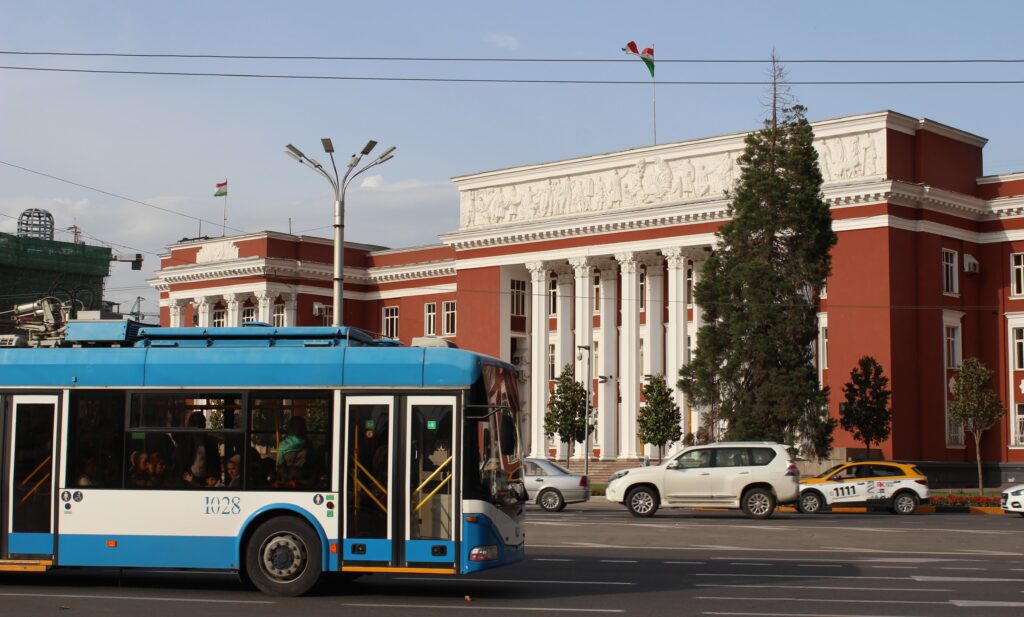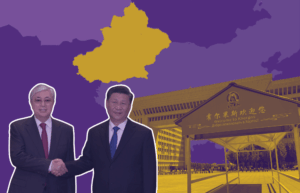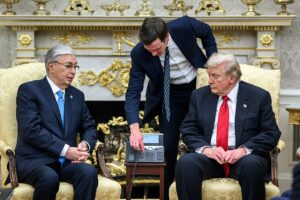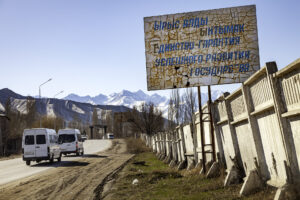Traffic congestion is a major problem in urban centres around the world, as vehicle emissions pollute air quality and cause significant environmental and health issues. Central Asian governments have been slow to adapt to this reality. Although local authorities in several major cities are trying to turn the tide by investing in prestigious rail projects, including light rail and metro, urban transit options remain limited overall. A Novastan review of urban public transport developments in Central Asia.
Twice a day during peak hours, Dushanbe, the capital city of Tajikistan, grinds to a halt as its broad Soviet-era boulevards are clogged with traffic. The city faces significant congestion issues, exacerbated by a population that has doubled since gaining independence from the USSR in 1991. Car ownership has increased even faster, doubling over the past decade. Existing infrastructure is unable to keep up with this rapid growth and resulting environmental problems caused by vehicle emissions have severely impacted air quality in Dushanbe.
To deal with the challenges of rapid urbanisation, city authorities are exploring options to build a metro system. Domestic know-how on building this infrastructure is virtually non-existent, which is why the government has reached out to South Korea. In 2022, Tajikistan’s transport ministry signed a memorandum of understanding with the South Korean National Railway Corporation to assess the feasibility of the project. Novastan reported earlier that the ministry expects to start detailed planning for the construction of what would be Dushanbe’s first metro line in mid-2025.
Urban rail has clear benefits over, for example, buses or trolleybuses, in that trams and metros are more effective in reducing traffic congestion and air pollution, and have a much higher capacity than most other modes of transport. Moreover, they are a sign of progress, which is why many urban rail developments are often also prestige projects. However, a metro system cannot replace city buses and other less flashy forms of public transportation, particularly in areas where building urban rail is not economically viable.
Trolleybuses – an endangered species?
In Naryn, a provincial capital in central Kyrgyzstan, for example, local lawmakers recently decided to dismantle their city’s trolleybus system. Located at an altitude of just over two thousand meters, Naryn boasted the highest trolleybus network in the world. Hence it was a source of local pride and a tourist attraction among public transport aficionados. However, due to the deteriorating condition of the infrastructure, as well as high maintenance costs, the city council voted to discontinue service. As a replacement, there are plans to purchase ten diesel buses, which will obviously contribute to air pollution.
The decision to abandon the Naryn trolleybus system follows last year’s announcement that Bishkek would do away with its large trolleybus fleet. A recent longread by the Kazakh media outlet Vlast highlights that this decision faced significant backlash, as Kyrgyzstan’s government had received long-term financial support from the European Bank for Reconstruction and Development (EBRD) to upgrade the network. For reasons unclear, the local authorities opted to replace the fleet with new electric buses, a transition co-financed by the Asian Development Bank (ADB). To prevent violating the credit agreement with the EBRD, “Bishkek’s mayor’s office said it paid off the EBRD loan, essentially making the city pay two loans for one mode of public transport since the trolleybuses were halted on November 8.”
Read more on Novastan: Last stop – Bishkeks trolleybuses on the brink of extinction (in German)
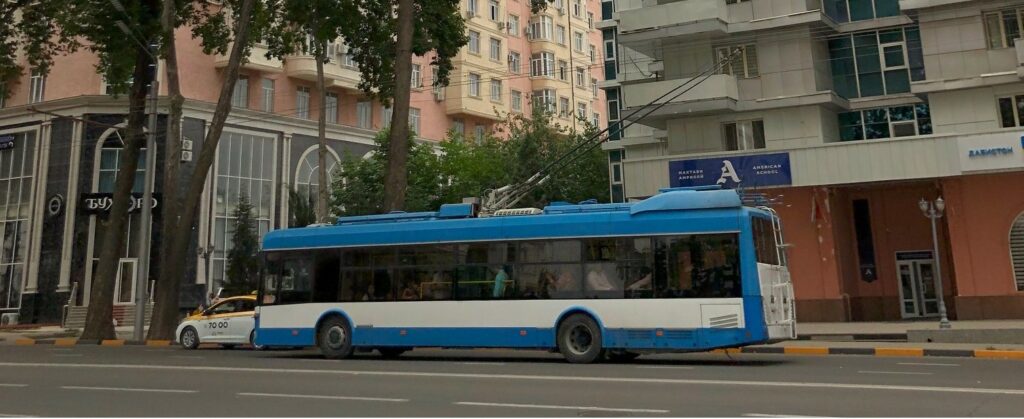

Authorities decided to transfer most of the old trolleybus fleet to other cities in Kyrgyzstan, a move many critics have called “a distraction for the inadequacy of the whole project.” Vlast already reported that the transfer of these buses “greatly exceeds the local demand and the capacity for local infrastructure to absorb them.” Still, around one hundred trolleybuses were transported to Osh, the country’s second-largest city, which now operates the country’s only remaining trolleybus network. There was also talk of moving buses and infrastructure, such as electrical substations, to Batken, Kara-Balta, and Tokmok – none of which have any active trolleybus lines. Naryn also received six trolleybuses, even though these proved no longer needed after the recent city council decision to permanently abandon the system. In the end, most vehicles will likely end up rusting away in local storages. Meanwhile, Bishkek activists have launched a legal effort to preserve the city’s trolleybus network from total dismantling.
A UN commission estimated that trolleybuses cost cities forty percent less than operating electric buses. Yet, local governments in Central Asia are forced to improvise if they wish to take back control over public transport in their cities. After the collapse of the Soviet Union in 1991, funding for municipal transportations systems virtually evaporated. The decline of public transit gave rise to privately-owned alternatives such as informally-operated minibuses, commonly known as marshrutkas. These minibuses largely followed well-established bus routes, but have the additional advantage of being able to navigate narrow and bumpier roads in city suburbs and other outlying neighbourhoods, something which trolleybuses obviously cannot. In short, the marshrutkas offer far better service that people are willing to pay for.
Read more on Novastan: Change through mobility – the marshrutka project (in German)
Another challenge to urban public transport in Central Asia is the rise of ride-hailing apps, such as YandexGo. In comparison to other intra-city transit options, ridesharing apps generally offer greater convenience and comfort. An article by The Diplomat explains how in cities and towns not yet serviced by YandexGo, taxi services which charge fares based on a standardised meter have grown in popularity. “To utilize these services, customers have to phone a call center, where they are connected to an operator who asks where they are currently located, where they want to go, and other logistical questions like number of passengers or luggage needs. The operator then connects the caller directly to a driver, who asks many of the same questions but with more detail, and usually will give an estimated wait time.”
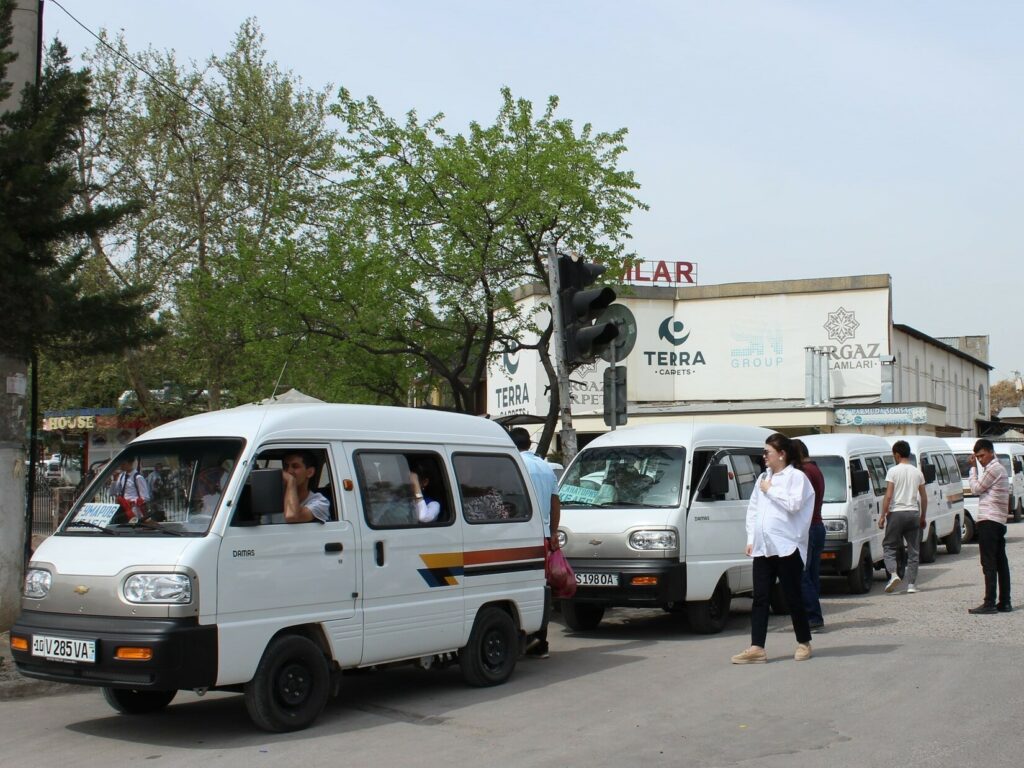

The return of the tram
But not only trolleybuses have fallen victim to the erosion of public transit in Central Asia. Trams have also grown increasingly rare. Tashkent, for example, had one of the biggest tram networks in the former Soviet Union until it was gradually dismantled in the early 21st century. The last route closed down in 2016 and most trams were transported to Samarkand, where one year later – in 2017 – a ‘new’ tram system opened using much of the old Tashkent tram infrastructure. Meanwhile, in Tashkent, the authorities already seem to regret their decision to dismantle their once great tram network. According to the Uzbek news outlet Kun.uz, a plan for bringing back tram service in Tashkent was agreed upon during President Shavkat Mirziyoyev’s recent visit to France on March 12, with the French firm Alstom reportedly set to construct a nearly ten kilometre long tram line.
There are only a handful of active tram networks left in Central Asia, most of which are in dire need of maintenance. In Öskemen, formerly known as Ust-Kamenogorsk, the unofficial capital of eastern Kazakhstan, tram operations were suspended in 2018 as the operator went bankrupt. Yet, with the help of the regional government, operations could be resumed later that year, after a number of old Almaty trams were transferred to Öskemen. Infrastructure repair works have since begun, and, in 2022, an order was placed for additional rolling stock at a Belarussian firm.
Up north, the city of Pavlodar boasts the largest tram system in Kazakhstan. The city successfully navigated the post-Soviet collapse of public transport in Central Asia, and authorities are even exploring options to expand the network. In doing so, the EBRD announced in 2024 that it would provide a loan to the Pavlodar tram management company to fund the purchase of battery-powered trams capable of operating without overhead catenary lines, thereby lowering infrastructure maintenance costs.
Also in the city of Temirtau, home to the largest steel factory in Kazakhstan, new Chinese-made trams were recently commissioned into service after a brief suspension of operations following a series of overhead line thefts. The city’s single tram line is now operated by JSC Qarmet, the owner of the steel plant, and mainly serves to transport employees to and from the factory. However, the new trams may not meet with approval from everyone. In an interview with a local news website, users complained about poor visibility from the windows. A director of one of the companies involved in the recommissioning of the Temirtau tramline wittingly replied that “Temirtau is beautiful in its own way in the dark, so it’s better not to look at it” – a joke referring to the city’s notorious reputation as one of the ugliest and most polluted cities in Kazakhstan.
Visions of modernity: light rail & metro
All jokes aside, public investments in the region’s few remaining tram networks are rare. Instead, city authorities across Central Asia have abandoned existing systems without providing proper alternatives, forcing people into overcrowded city buses or privately-owned marshrutkas. But now that urban rail seems to gain traction in Central Asia, regional governments appear to prefer light rail and metro options, both of which are generally more expensive and more complex to construct, operate, and maintain than trams.
Currently, only Tashkent and Almaty have metro systems. In Tashkent, construction of the first line started in 1972, six years after a devastating earthquake had leveled most of the city. Since then, the network has expanded to four lines, around fifty stations and an annual ridership of several hundred million. There are a couple of plans for further expansion, and the construction of an important circle line is currently ongoing. For those passionate about urban rail, the Tashkent metro is an absolute must-see. It is the archetype of urban rail in Central Asia. Most Soviet-era stations are lavishly designed and decorated, with the architecture and decor of each station reflecting its name.
By contrast, the Almaty metro consists of a single line. Although construction started in the late 1980s, the newly independent government of Kazakhstan was unable to finish the project after funds from Moscow dried up following the collapse of the USSR. Construction resumed in the 2000s, and most of the Almaty tram network was disassembled in anticipation of the metro’s opening in 2011. In retrospect, a strange decision considering the fact that the tram lines followed different routes than the new metro line, had way more stops, and hence would have been a great supplement to the metro system. Similar to Tashkent, there are ambitious plans to revive the Almaty tram – albeit now as a light rail.
This year, the region will also see the long-awaited opening of the Astana light rail, or light metro, connecting the city’s airport with the main train station. Construction of this system started back in 2011, but was put on hold multiple times because of problems with funding and a corruption scandal, in which “officials and Astana LRT [light rail transit] executives had inflated contracts and embezzled the difference, which a court later heard ran to 5.8 billion tenge ($13 million at current exchange rates).” For many years, a series of massive concrete pillars stood as silent reminders of the unfinished project, until in 2023, Kazakhstan’s President Kassym-Jomart Tokayev ordered it to be completed. Meanwhile, the Kazakh news outlet Orda.kz reports that the search for those involved in the embezzlement of public funds is still ongoing.
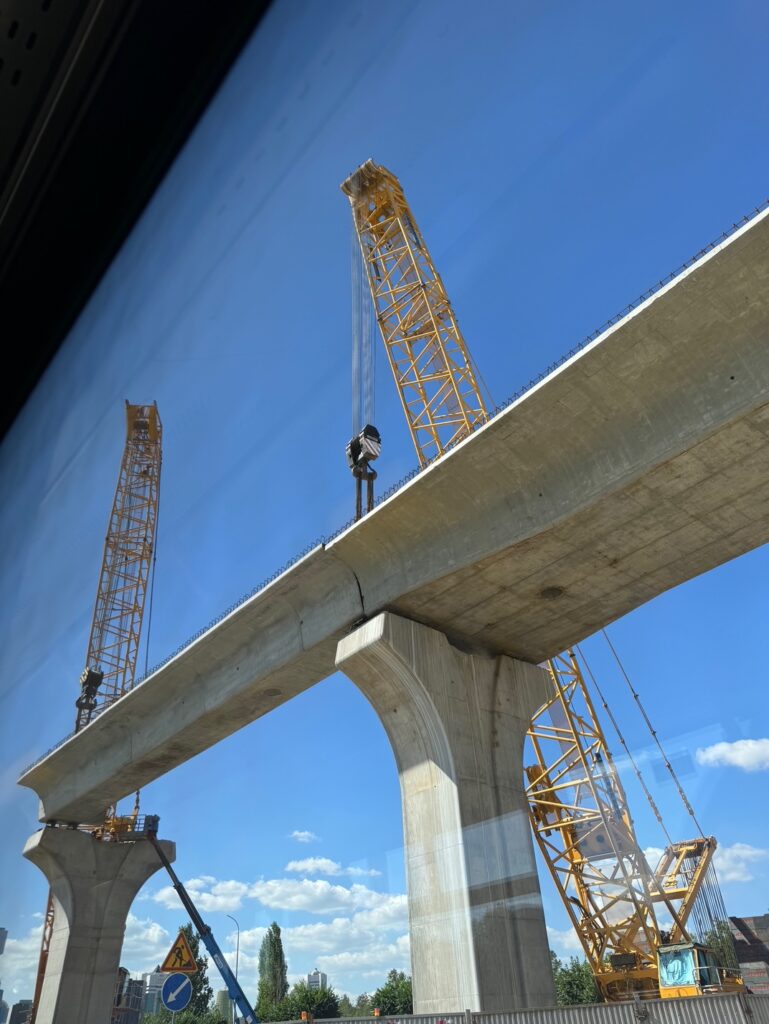
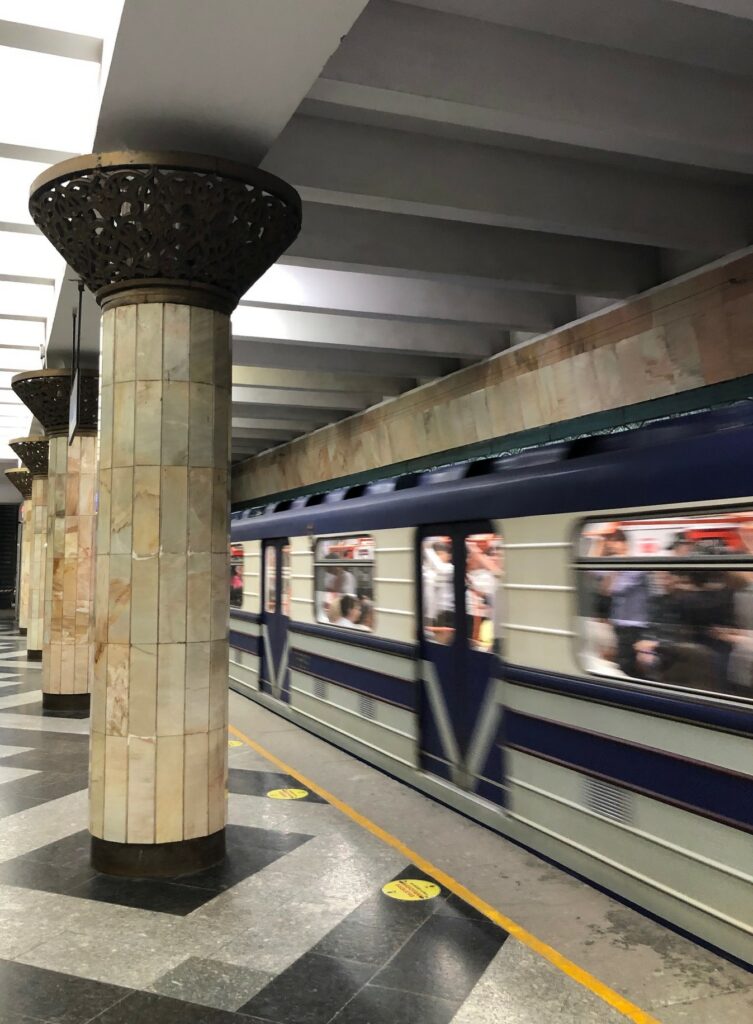
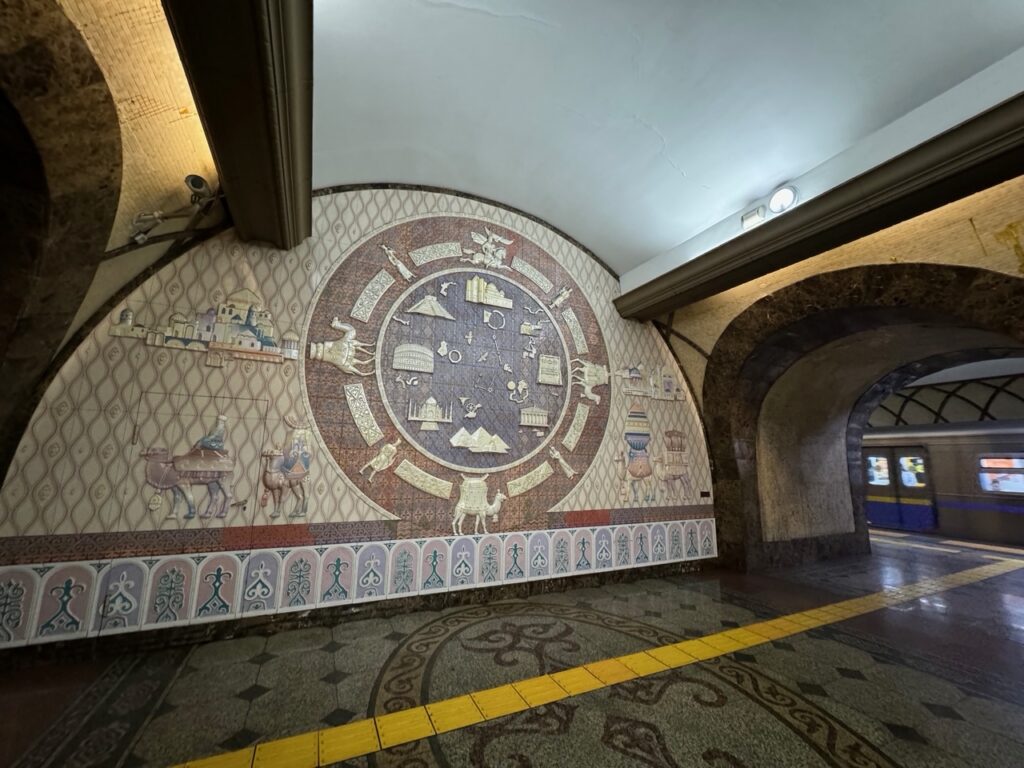
The crucial role of regional governments
In short, most problems related to public transportation in Central Asia are the result of poor planning and haphazard decision-making. Regional governments have largely failed to take back control over public transit in the wake of the collapse of the Soviet Union. Although in some major cities, such as Dushanbe, there is discussion about developing modern light rail and metro systems, basic public transport options, such as (trolley)buses, remain inadequate. In fact, in many cities, big and small, these services are still being whittled away.
Apart from such infrastructure-related issues, a World Bank specialist concluded that the poor state of public transit in Central Asian cities is also in large part “due to regulated fixed fares (which are insufficient to meet operating expenses), a high number of fare exemptions for multiple categories of people, and the inability to provide state subsidies on a stable basis.” As such, local authorities are not only part of the problem – they also hold the key to improving urban mobility.
Text and photos by Julian Postulart
For more news and analysis from Central Asia, follow us on Twitter, Facebook, Telegram, Linkedin or Instagram.
 Navigating the gridlock: Central Asia’s struggle with urban public transit
Navigating the gridlock: Central Asia’s struggle with urban public transit 
